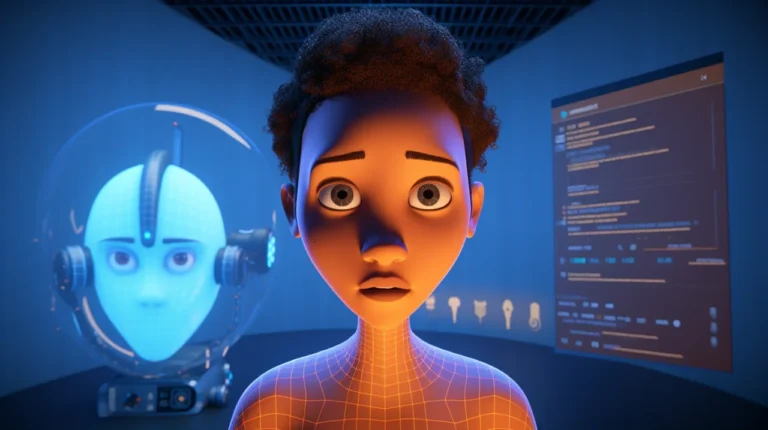Arcs in animation refer to the smooth, curved paths that most natural movements follow. Instead of moving in straight lines, characters and objects tend to move along arcs, which creates more realistic and visually pleasing motion. Animation has the ability to breathe life into illustrated worlds and characters on screen. One of the key technical elements that contribute to believable, appealing animation is the use of thoughtfully crafted arcs.
In this article, Let’s analyze what arcs are and get to know the origin of this technique on a mechanical level and how this technique helps create realistic, compelling motion.

Need Animation Services?
Visit our Animation Service page to see how we can help bring your ideas to life!
Defining Arcs
As one of the 12 principles of animation, an arc can be defined as the curved path that an object or character follows as it traverses through space in the scene. Rather than moving from point A to point B in stiff straight-line motion, arcs introduce organic acceleration and deceleration to the movement. This mimics the principles of physics that govern objects in the real world.
Very few organisms are capable of moves that have mechanical in-and-out or up-and-down precision; the action of a woodpecker might be an exception. And, because of the restriction
Arcs are mathematically shaped following circular or elliptical trajectories rather than linear ones. The curvature creates visible easing in and out of the motion over time. This is directly related to the changing rate of speed over the arc, with objects accelerating to full speed at the apex of the curve and decelerating as they come to rest at the endpoints.
This contrasts with linear motion, which demonstrates a constant velocity without acceleration. Consequently, implementing thoughtful arcs into all aspects of character and object animation adds significantly to the illusion of weight, momentum, and natural movements responding real-world physics.
Taxonomy of Arcs
There are several fundamental varieties of arcs commonly employed in animation:
Circular Arcs
These arcs follow a precise circular path along the circumference of a circle. The radius stays equidistant throughout the curve. Circular arcs work well for motions like spinning, rotations, pendulum swings, and other cyclic motions with rotational symmetry.
Elliptical Arcs
Elliptical arcs follow the circumference of an oval shape. This creates asymmetric acceleration and deceleration phases, with faster motion occurring near the center of the ellipse. Elliptical arcs provide a nice midpoint between circular and linear paths, lending more naturalistic motion for actions like jumping or throwing.
Irregular Arcs
These arcs follow a loose, organic pathway that does not adhere to any geometric shape. The curves along the path are uneven and varied. Irregular arcs produce extremely natural motion for irregular actions like a fluttering flag or leaves blowing in the wind.
Applications of Arcs
Carefully engineered arcs serve several important functions in enhancing animated content:
Weight and Mass
Arcs lend a genuine sense of weight and mass to objects and characters. The seeming influence of gravitational forces makes objects feel substantive rather than weightless.
Overlapping Action
Intersecting arcs multiply the complexity and dynamism of a scene through intricate overlapping actions between elements. This greatly enhances a sense of lively motion.
Exaggeration
In character animation services, arcs allow animators to push motion to exaggerated extremes for dynamic, captivating results. Actions become amplified beyond natural proportions following cartoon physics theory.
Personality and Emotion
The timing and intensity of the arcs convey personality and emotion. Chaotic arcs feel nervous, while gentle arcs feel calm and graceful. Arcs enrich characters.

Notable Examples from Animation History
Many quintessential moments in animation exemplify the masterful use of arcs in character and scene animation:
Luxo Jr.: The animation of the precocious desk lamp in this pioneering Pixar short relies on squashed, stretched circular arcs to bring it to life through energetic bouncing motions.
Mr Incredible: In Pixar’s The Incredibles, Mr. Incredible’s immense strength is humorously conveyed by wide, sweeping arcs as he lifts vehicles high into the air with ease and enthusiasm.
Carl’s Shuffle: In the opening minutes of Pixar’s Up, Carl’s movements as an elderly man follow understated arcs that communicate his fragility through a hunched, wobbling shuffle.
Elsa’s Gestures: During the musical number “Let It Go” in Frozen, Elsa’s elegant arm motions trace grand sweeping arcs befitting an ice queen conjuring up a snowy domain.
Baymax’s Waddle: Disney’s Big Hero 6 character Baymax moves along gentle, irregular waddling arcs dictated by the inflation and flexibility of his soft vinyl body.
Best Practices for Animating with Arcs
Here are some key tips for implementing effective arcs in your animation workflows:
Plot out foundational arcs in storyboards and layout prior to animating. Don’t just connect poses. Utilize spline and bezier curves in software to avoid linear interpolation between poses. Conceptualize arcs volumetrically in 3D space, not just flat 2Dplanes.
Time accelerations and decelerations gradually with appropriate easing for natural physics.
Study live-action video reference to observe real arc pats in motion.
Give inanimate objects appeal through well-timed, dynamically shaped arcs. Layer multiple intersecting arcs between elements to increase complexity. Push heroic or intense moments through bigger, exaggerated arcs.
Conclusion
Whether crafting a bouncing ball, an athlete mid-jump, or a superhero’s dramatic action sequence, arcs lend animation the magical illusion of life. They ground characters in their environments, revealing the forces at work on their bodies. Understanding the science behind arcs allows animators to transcend technical limitations and create the illusion of life.
So take the time to meticulously plot arcs for all motion, not just key poses. Observe their effect on the timing, weight, and personality of your animation. A mastery of arcs can make all the difference in crafting animation that feels subtly yet profoundly alive.












